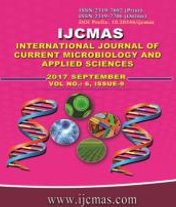


 National Academy of Agricultural Sciences (NAAS)
National Academy of Agricultural Sciences (NAAS)

|
PRINT ISSN : 2319-7692
Online ISSN : 2319-7706 Issues : 12 per year Publisher : Excellent Publishers Email : editorijcmas@gmail.com / submit@ijcmas.com Editor-in-chief: Dr.M.Prakash Index Copernicus ICV 2018: 95.39 NAAS RATING 2020: 5.38 |
Acinetobacter has developed resistance against a number of broad spectrum drugs and is considered as multi-drug resistant bacteria. Metallo-beta-lactamase (MBL) production is important mechanisms of the resistance as they can hydrolyse almost all beta-lactam antimicrobial agents. To isolate Acinetobacter species from different clinical specimens and to determine their antimicrobial susceptibility pattern as well as to know the rate of MBL production. The study was done in Department of Microbiology, RMC, Loni. The clinical samples were subjected to Gram staining, aerobic culture using MacConkey and blood agar. Acinetobacter species were identified by standard microbiological identification methods. Antimicrobial susceptibility testing was done by Kirby Bauer disc diffusion technique and according to CLSI guidelines. The Imepenem resistant strains were subjected to MBL detection by Disk Potentiation test (DPT) and Epsilometer test. A total of 101(2.18%) Acinetobacter species were isolated out of 4627 clinical samples. Rate of isolation was maximum from burn department (38) followed by ICUs (23). A. baumanii (71) was the commonest species isolated followed by A. lowfii (18). The isolates were highly resistant to cefotaxime (100%), Co-trimoxazole (87%), Ciprofloxacin (78%), Cefepime (77%), Gentamicin (73%). All isolates were sensitive to Colistin. The number of MBL producing strain by DPT and E-test were 42 & 40 respectively. MBL production was detected better by DPT than E-test, therefore can be used as better screening method. Emergence of MBL producers and multidrug resistance in hospitals is alarming and reflect excessive use of carbapenems. Therefore early detection and prompt infection control measures are needed.
 |
 |
 |
 |
 |